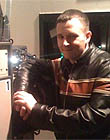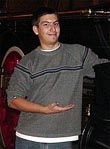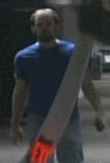|
|
This topic comprises 3 pages: 1 2 3
|
|
Author
|
Topic: What happened to my tail leader?
|
|
|
|
|
|
|
|
|
John Hawkinson
Film God

Posts: 2273
From: Cambridge, MA, USA
Registered: Feb 2002
|
 posted 06-29-2004 10:07 AM
posted 06-29-2004 10:07 AM




I can't say I pay a huge amount of attention to winding orientation, but I know that TES makes an effort to ensure a consistent orientation when they ship out prints. I don't know if they do so on lab-new prints, though. Did this change with the Sony move to ETS?
The fact is, though, if it were really important, it wouldn't be difficult for the labs to keep it consistent. If they're loop-printing, then all reels will come out the same way, so it's just a matter of starting the negatives the same way.
If they're bidirectional-printed, then they can just sort the reels in two piles, and when they "make" a print, pick head-out versions of all reels or tail-out versions of all reels.
(Same deal if a reel get's pulled for QC. I suppose if all reels came out head-out (loop printed), then the tail-out pile might consist solely of pulled reels, and so if you got one QC'd reel that would mean you'd have an entire print that was QC'd, and that might be either good ("known quantity") or bad ("this reel has been run through a projector; it has greater chance of damage") depending on your perspective.)
But it should be easy for theatres to rewind. In the ideal world, everyone would have a handy Goldberg automatic rewinder (suitably configured to not cinch), and then it's really no effort to toss the next reel on while you're inspecting the previous.
--jhawk
| IP: Logged
|
|
|
|
|
|
|
|
John Pytlak
Film God

Posts: 9987
From: Rochester, NY 14650-1922
Registered: Jan 2000
|
 posted 06-29-2004 02:42 PM
posted 06-29-2004 02:42 PM





Normally, the labs print several complete copies of the same reel on each large roll of raw stock, which then is put on the ECP-2D processing machine. After the film is processed and dried, it goes through a high speed viewer (video or rear screen projection) for inspection by the take-off operator. The operator lets one reel wind up onto a new core, then has a few seconds to cut the film between the reels, and wind the next reel onto a core. If the operator is distracted, they may accidently make the cut in the middle of a reel, instead of between two reels. Normally mistakes like this are caught since the reel ID / bar codes will not be on the outer lap of the reel.
In most cases, the lab ships the prints to the film exchange on cores, as complete features (tracking bar codes and/or CAP codes on each reel to be sure each shipment has all the correct reels). The exchange "mounts" the film onto shipping reels, usually by simply putting the two flanges of the shipping reel onto the core. Mounting involving a rewind step is rarely used today. The film is then put into the shipping case / box for shipment to the theatre. (This the practice in the USA).
| IP: Logged
|
|
|
|
|
|
|
|
Brad Miller
Administrator

Posts: 17775
From: Plano, TX (36.2 miles NW of Rockwall)
Registered: May 99
|
 posted 06-29-2004 07:56 PM
posted 06-29-2004 07:56 PM




The biggest complaint boils down to multiplexes who get their prints on Thursday afternoon/evening, then have very little time to get all of the prints built before the night is over. Having to rewind half of the reels (2K reels at that) takes up quite a bit of time, even compared to having to rewind 6K reels. The basic groups are:
1. Changeover projectionists, of which there are extremely few in the big picture. (Plus they are used to constant rewinding anyway.) We will assume that any changeover projectionists are at least well trained enough to do a full inspection before running the show.
2. Platter projectionists who build straight from shipping reels to the platter. Yeah those guys suck, but it's amazing just how many do it like that. For this group, all heads out is a bonus.
3. Platter projectionists who build onto Goldberg platter reels. For these guys, having all heads out is a bonus.
4. Platter projectionists who build onto large (typically "hour length" reels), then platter from there. This group would generally prefer tails out orientation, but since most platter houses have 2 rewind benches, it's really no big issue at all to start a 6K rewinding on the other bench while you work on the other half of the print. Also, I think more and more of this quality conscious group are switching to platter reels.
Any way you slice it, all heads out is the overwhelming preference. However if the reels cannot arrive all heads out, I do agree that most everyone I know would prefer they all arrive tails out than a mix-and-match orientation. Group 2 in this instance will simply build to 6K reels, then platter and group 3 will build to 6K reels, then rewind to the platter reel.
Not sure if that really answers Steve's question, but for what it's worth.
jhawk - shame on you for rewinding reels with masking taped-on leaders in a rewinder. (Actually, shame on you for using those evil things in the first place, but that's another argument.) Have you never seen what commonly happens to the ends of the reel? The edges get creased, sometimes the film gets flipped over and almost always the film gets a nice fold in it. Of course this wouldn't be an issue if morons would start breaking down with a splicer. ![[Mad]](mad.gif)
| IP: Logged
|
|
|
|
|
|
|
|
All times are Central (GMT -6:00)
|
This topic comprises 3 pages: 1 2 3
|
Powered by Infopop Corporation
UBB.classicTM
6.3.1.2
The Film-Tech Forums are designed for various members related to the cinema industry to express their opinions, viewpoints and testimonials on various products, services and events based upon speculation, personal knowledge and factual information through use, therefore all views represented here allow no liability upon the publishers of this web site and the owners of said views assume no liability for any ill will resulting from these postings. The posts made here are for educational as well as entertainment purposes and as such anyone viewing this portion of the website must accept these views as statements of the author of that opinion
and agrees to release the authors from any and all liability.
|

 Home
Home
 Products
Products
 Store
Store
 Forum
Forum
 Warehouse
Warehouse
 Contact Us
Contact Us




 Printer-friendly view of this topic
Printer-friendly view of this topic





![[Big Grin]](biggrin.gif)








![[Confused]](confused.gif)

![[Mad]](mad.gif)



